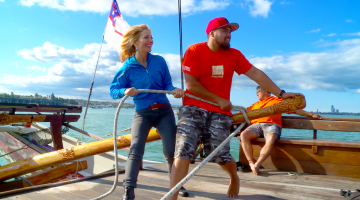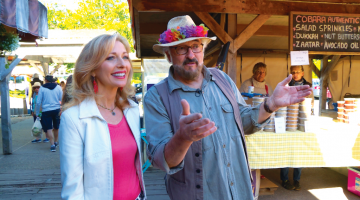Linda exchanging energy above in a traditional Maori greeting/welcoming ceremony
The Maori are the indigenous inhabitants of New Zealand. Culturally, they are Polynesians, most closely related to eastern Polynesians. After contact with Europeans, the people now known as the Maori began using the term tangata maori, meaning “usual or ordinary people,” to refer to themselves.
Ceremonies and Beliefs
Most public rites were performed in the open, at the marae. The gods were offered the first fruits of all undertakings, and slaves were occasionally sacrificed to propitiate them. Incantations (karakia ) were chanted in flawless repetition to influence the gods.
Because spiritual forces such as mana, tapu and mauri were seen as all-pervasive, people navigated the spiritual world through karakia and ritual. Most ceremonies and rituals required the services of tohunga.
Most activities involving the cultivation or collection of food were under the domain of an atua. The first fruits were reserved for the relevant atua.
- People fishing would throw their first catch back for Tangaroa, god of the sea. In one traditional story, Manuruhi, the son of Ruatepupuke took a fish without saying a karakia to Tangaroa, and did not offer up the first of the catch. Tangaroa was enraged. He came and took Manuruhi under the sea, and turned him into a tekoteko on top of his wharenui.
- Rongo, the god of cultivated foods, would be offered the first kūmara harvested. The kūmara for offer were planted in a separate garden plot, called a māra tautāne.
- Bird fowlers offered their first catch to Tāne, god of the forest.
- Tūmatauenga, the god of war, would receive te mata-ika (the face of the fish), the first man killed in battle.
Tapu removal
There were a number of rituals to remove tapu and make a person or thing noa (free from the restrictions of tapu). Whakanoa means to make noa. Whakahoro was a ritual to remove tapu from people using water. Another ceremony was hurihanga takapau (turning the mat). This was used by Māui to lift the tapu from his great fish (the North Island).
Whāngai hau
Whāngai hau involved a ceremonial offering of food to an atua. It was to feed (whāngai) the essence (hau) of the offering to the atua.
Ngau paepae
A ceremony conducted to increase the tapu of warriors going into battle, and also to neutralise certain types of tapu, was ngau paepae (biting the beam between the two posts of a latrine).
Sickness was believed to be caused by sorcery or the violation of a tapu. The proximate cause of illness was the presence of foreign spirits in the sick body. The medical tohunga accordingly exorcised the spirits and purified the patient. The therapeutic value of some plants was also recognized.
The dying and dead were taken to a shelter on the marae. The body was laid out on mats to receive mourners, who came in hapu or tribal groups. After a week or two of mourning the body was wrapped in mats and buried in a cave, in a tree, or in the ground. Often after a year or two the ariki would have the body exhumed, and the bones scraped clean and painted with red ochre, to be taken from settlement to settlement for a second mourning. Afterward, the bones were given a second burial in a sacred place. The spirits of the dead were believed to make a voyage to their final abode, a vague and mysterious underworld.Ngau paepae
Word Key
- Mana: authority, power, psychic force, prestige
- Tapu: sacred; under religious restriction
- Mauri: life principle; material object that is a symbol of the hidden principle protecting vitality
- Karakia: incantation, charm, spell, ancient rites, invocation; Christian prayers
- Tohunga: priest; expert in traditional lore; person skilled in specific activity; healer
© Crown copyright 2005–2016 Manatū Taonga Ministry for Culture and Heritage, PO Box 5364, Wellington 6145, New Zealand. Tel: +64 4 499 4229; Fax: +64 4 499 4490; Email:TeAra@mch.govt.nz
Cengage Learning © Copyright 2016.





No Comment